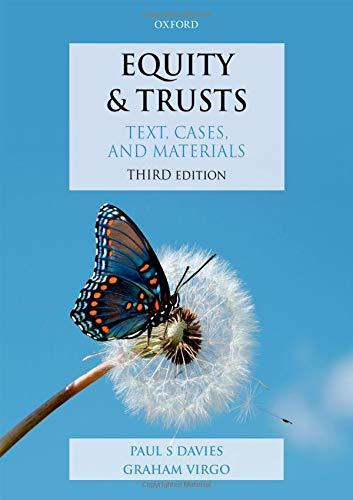Question
A. Analyze the following factual disputes. Would these disputes result in a civil case, a criminal case, or both? Explain your answer. If a civil
A. Analyze the following factual disputes. Would these disputes result in a civil case, a criminal case, or both? Explain your answer. If a civil case would result, who would be the plaintiff and who would be the defendant?
(1) Baron and Finkle sign a written contract in which Baron agrees to build a room addition to Finkle's house. When the contract was signed, Finkle gave Baron a $1,000 deposit. Before construction was to begin, Baron called Finkle and told him he would not be able to do the work. Baron has not returned the $1,000 deposit.
(2)Martin sets fire to a building he owns in order to collect insurance.
(3)Reese works as a software engineer for DATA Corp. and has been involved in the design of a new computer chip. He has signed a confidentiality agreement with DATA Corp. and has agreed that all products developed by him while working for DATA belong to DATA. Reese has a dispute with DATA over salary and leaves. He sells the design for the computer chip to DISK Corp., his new employer. DISK knows that the chip design was developed while Reese was working for DATA.
(4)Bates, in a fit of anger, kills his wife. The couple has two minor children.
(5)Rosemond Corporation is engaged in a business that produces by-products that pollute water. It illegally dumps the by-products. Children in a nearby area de- velop a high incidence of cancer.
B. The following lawsuits eventually resulted in landmark Supreme Court cases. Read the factual basis for the cases and state whether the case was a civil case or criminal case, explaining why.
(1)In this lawsuit, a group of children sued to be allowed to attend nonsegregated schools. The Supreme Court found that separate schools were unequal and held in favor of the children. (Brown v. Board of Education, 347 U.S. 483 [1954]).
(2) In this action, an indigent person was accused of committing a felony in the state of Florida. The state refused to provide him with a lawyer. He challenged his sub- sequent conviction claiming that his constitutional right to an attorney was de- nied. The Supreme Court agreed with the accused. (Gideon v. Wainwright, 372 U.S. 335 [1963]).
(3)After a high school principal edited articles in the school paper, members of the high school newspaper filed a lawsuit seeking injunctive relief, money damages, and declaration that First Amendment rights were violated by censorship of certain articles. The Supreme Court ruled against the students. (Hazelwood v. Kuhlmeier, 484 U.S. 260 [1988]).
(4)A teacher accused a minor student of smoking in the bathroom. When the stu- dent denied the allegation, the principal searched her purse and found cigarettes and marijuana paraphernalia. The state sought to have the young girl declared a delinquent. The minor claimed that the evidence found in her purse should be excluded at the delinquency hearing because it was obtained in violation of her Fourth Amendment rights. The Supreme Court ruled that her rights were not vio- lated. (New Jersey v. T.L.O, 469 U.S. 325 [1985]).
(5)Barbara Grutter sued the University of Michigan Law School for racial discrimina- tion claiming that she was denied admission to the law school because the schoolunlawfully used race as an admission factor. The school admitted that race was one of many factors, but that it used race in order to achieve a diverse student population. The Supreme Court disagreed with Grutter and held that institutions of higher edu- cation have a legitimate interest in promoting diversity and in this case, the school used race in a narrowly tailored manner. (Grutter v. Bollinger, 539 U.S. 306 [2003]).
(6)A young man committed a murder when he was 17 and was convicted of the crime after he turned 18. He was sentenced to die, and he challenged the sentence as cruel and unusual punishment. A majority of the Supreme Court agreed with Roper, and it held that to execute him for his crime would violate the Eighth Amendment. (Roper v. Simmons, 543 U.S. 551 [2005]).
(7)Various local public officials sued the New York Times for libel as a result of a story printed by the paper. The newspaper claimed that the public officials should not be able to recover because of the First Amendment right of freedom of the press. The Court found that in order to recover, the public officials needed to prove that the articles were published maliciously. (New York Times v. Sullivan, 376 U.S. 254 [1964]).
(8)A company holding the copyright to selected television shows sued manufacturers of videotape recorders used by individuals to record shows to view at a later time. The plaintiff asked for an injunction and for damages. The Court held that mak- ing of individual copies of complete television shows for purposes of time-shifting does not constitute copyright infringement, but is fair use. (Sony Corp. of America v. Universal City Studios, Inc., 464 U.S. 417 [1984]).
(9)An individual sued various secret service agents for money damages, claiming that they violated his rights when they questioned and arrested him because he made derogatory comments about the vice-president (whom the agents were guarding). The Court found that the officers had qualified immunity and could not be sued. (Reichle v. Howards, 132 S. Ct. 2088, 182 L. Ed. 2d 985 [2012]).
Step by Step Solution
There are 3 Steps involved in it
Step: 1

Get Instant Access to Expert-Tailored Solutions
See step-by-step solutions with expert insights and AI powered tools for academic success
Step: 2

Step: 3

Ace Your Homework with AI
Get the answers you need in no time with our AI-driven, step-by-step assistance
Get Started


